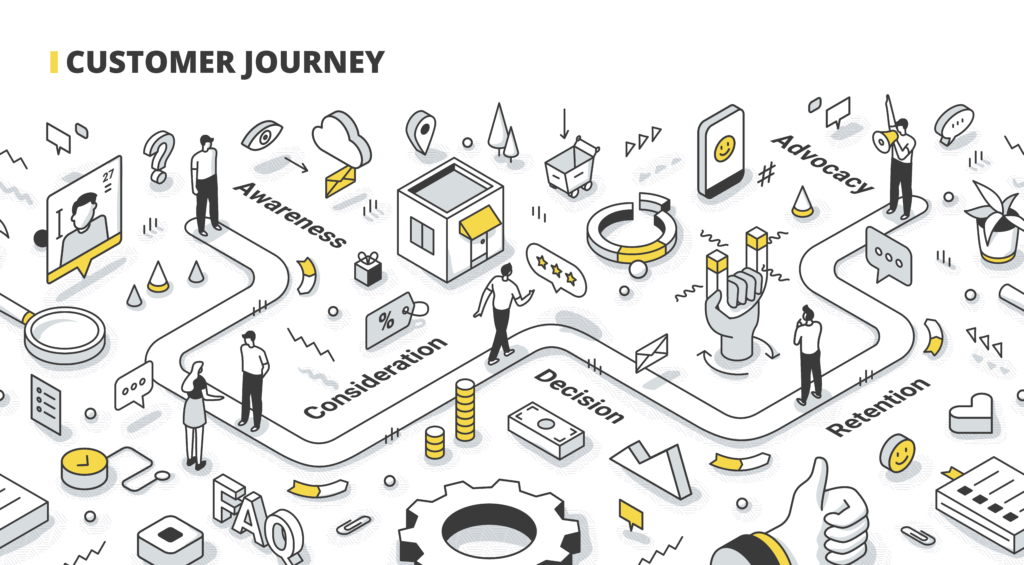These days, it’s more important than ever to understand every step your potential customers take on the road to making a purchase. That explains the recent shift in focus to customer experience (CX) or customer journey marketing, in which companies put their customers’ perspectives first to optimize each step of the customer journey and make the journey to purchase that much easier.
In fact, according to Anne Lewnes, EVP and CMO of Adobe, the term “customer experience” (CX) may eventually become redundant since every savvy business will be thinking customer-first. And Salesforce has reported that a whopping 80% of customers consider their experience with a company to be as important as its actual product.
If you want to be one of those savvy customer-first businesses, you need to take a careful look at your customers’ journey to a purchase and optimize each step to make your customer’s experience as seamless as possible.

What is a customer journey?
You may be familiar with the concept of the sales funnel — a model of the sales and marketing process from your business’ point of view. The sales funnel tracks the progress of your leads from the top of the funnel and through steps of your sales/marketing strategy until they reach the bottom of the funnel, where they come to the point of purchase and (hopefully) take the final step of becoming your customer.
The customer journey is a similar concept, but it’s been updated to the modern digital marketing landscape and, crucially, looks at the process from the customer’s POV rather than yours as the marketer. It can help marketing professionals more deeply understand the needs and motivations of their potential customers, improving customer experience at every touchpoint and leading to higher conversion rates and better customer retention.
A customer journey map is a detailed visualization of your customer’s journey from the first time they encounter your brand all the way to making a purchase or signing up for services. The map includes each and every touchpoint a potential customer has with your brand as they consider making a purchase, from receiving a marketing email to visiting your site for more information.
Benefits of mapping customer journey
While the sales funnel is linear and simplified, the map of a customer journey can be longer and more meandering. Of course, today’s customer journey is rarely linear and straightforward, so a customer journey map tends to be a more accurate depiction of today’s customers’ decision-making processes.
Customers may require eight or more touchpoints with your brand before making a purchase, and different customer personas may follow different customer journeys. While one type of customer may know exactly what they want and require fewer steps to make a purchase, others may require more research and time and, therefore, will have a longer customer journey.
You can create multiple customer journey maps tailored to each type of customer you wish to attract, taking into account how each type is encountering your brand, the way they research your products or services, the hurdles they may encounter, and how they ultimately make the decision whether or not to become your customer.

How to create a customer journey map
1. Set a goal
To create your own customer journey map(s), first, establish a goal for the project. Do you want to simply improve your online sales, or do you want to improve your overall customer experience to retain customers and engender loyalty?
2. Do your research
Next, you’ll need plenty of data in order to get a clear idea of your customer journey. Collect as much information as possible on your customers and their needs through customer questionnaires, user testing, and other methods.
How are they discovering your brand? Which digital channels are they using to learn more information about your products and services? What kinds of hurdles are keeping them from making a final purchase decision?
3. Hone in on your buyer personas
Once you’ve collected this information, you should know enough to create one or two buyer personas outlining the motivations and desires of your average desired customer. If this is your first time making a customer journey map, you may want to hone in on one buyer persona first and map out their journey in detail.
4. List the customer’s brand touchpoints
It’s finally time to map your buyer’s journey to becoming a customer! Based on your research, list out all the touchpoints your prospects currently interact with, as well as those you’d like them to take once you’ve employed your new CX strategy.
Consider all the ways your customer might find you online — not just your website but your social channels, video content, paid ads, marketing emails, and third-party reviews.
5. Continue to optimize your map
Your customer journey maps should be a living document that continually changes as the landscape and your customers’ needs change. Ensure that you’re constantly reviewing your map and updating it as you collect fresh data about your customers using analytics, customer reviews, and feedback.
Looking to drive value from Google Ads for your business?


